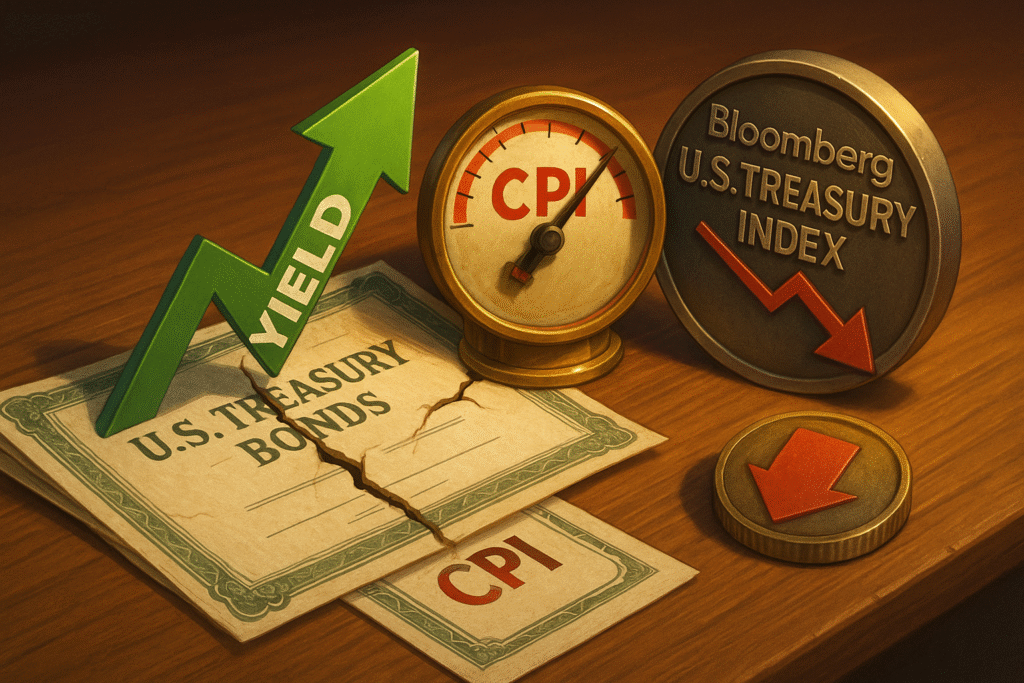A hotter-than-expected U.S. consumer-price report sent bond yields flying. That treasury yield spike triggered the Bloomberg U.S. Treasury Index’s worst day of 2025. The sharp move has bond investors asking how much duration risk they should hold.

CPI shock sets off heavy selling
Headline inflation printed 4.0 percent year-over-year, above forecasts of 3.7 percent. Core inflation held at 3.4 percent, showing sticky services costs. Traders reacted fast. A spike in treasury yields resulted, with the ten-year yield jumping 19 basis points to 4.65 percent, its highest close since November. Notably, such a treasury yield spike has erased hopes for summer rate cuts as two-year yields climbed to 5.10 percent. Futures now price just one 25-basis-point cut by year-end versus three cuts a month ago.
One-day damage to the Bloomberg Treasury Index
The Bloomberg U.S. Treasury Index lost 1.2 percent on the session. That drop marks its steepest single-day slide this year. Long bonds bore the brunt. The 30-year benchmark fell nearly three points, as its duration hovers near 16 years. Even short notes slipped because front-end yields rose. The index is now down 2.6 percent year-to-date, erasing April’s modest gains.
Key numbers from the sell-off
- 10-year yield: 4.65 percent, +19 bp
- 30-year yield: 4.77 percent, +15 bp
- Bloomberg Treasury Index: –1.2 percent on the day
- Total market value lost: about $270 billion
Why the treasury yield spike hurts duration holders
Duration measures how much a bond’s price moves when yields change. A one-point rise in the 10-year yield can knock long-bond prices down 17 percent or more. Many investors extended duration in late 2024, betting on a soft landing and lower policy rates. That trade worked in January and February. Now, hotter data have flipped the narrative. The yield curve no longer screams recession; instead, it signals sticky inflation. For example, funds experiencing the spike in yields are seeing the effects first with long Treasuries.
Positioning and flows after the shock
Exchange-traded funds saw quick outflows. The iShares 20+ Year Treasury Bond ETF lost $950 million in one day. Short-duration funds gained $400 million, showing a dash for defensive notes. Dealers reported heavy selling from overseas reserve managers and U.S. pension funds. Futures positioning shifted too. Asset managers trimmed long ten-year contracts, while hedge funds added fresh shorts, betting yields have more room to run after a spike in treasury yields.
What could change the outlook
Three factors may calm the bond market:
- Economic slowdown
If job growth cools below 100,000 per month, demand for safe assets should rise. Lower growth also caps wage gains, easing core inflation. - Fed communication
Chair Powell could stress data-dependence without ruling out rate cuts. Clear guidance often soothes rates volatility. - Supply relief
The Treasury Department may tweak auction sizes. Smaller long-bond issuance would remove some upward pressure on yields.
Yet risks remain. Another hot inflation print or a jump in energy prices would keep yields climbing, contributing to a sustained treasury yield spike. A widening federal deficit, now projected at $1.8 trillion for fiscal 2025, also adds supply pressure. Foreign buyers own a shrinking share of new issuance, forcing domestic funds to absorb more duration.
Managing duration in a volatile rate world
Bond managers have several tools:
- Barbell strategy
Hold short bills and a small slug of long bonds. Bills offer yield with little price risk. Long bonds hedge tail events like recession. - Floating-rate notes
Some prefer Treasury FRNs, which reset every week. FRNs avoid big price swings when yields spike. - Treasury futures hedging
Funds that must own long bonds can short futures to offset duration temporarily. The cost is margin rather than lost coupon. - Cross-market spreads
Investors can own Treasuries but short German Bunds if they think Europe will cut sooner. This relative-value trade limits outright duration risk.
Long-term takeaways from the treasury yield spike
History shows big one-day rate moves often fade, yet they leave scars. The Bloomberg Treasury Index lost over 12 percent in 2022 when yields surged. It clawed back some ground in 2023 but remains far below its 2021 high. Following the treasury yield spike, long-duration investors earn higher coupon income today, which cushions future losses. Still, timing matters. Buying duration too early can hurt year-to-date returns for balanced portfolios.
Eyes now turn to next month’s CPI and the June Fed meeting. If inflation cools even modestly, treasury yields could drift back below 4.4 percent. If not, 5 percent on the ten-year is in play, and the index could see another rough patch. Active monitoring and nimble positioning will be vital for anyone holding long Treasuries in 2025.